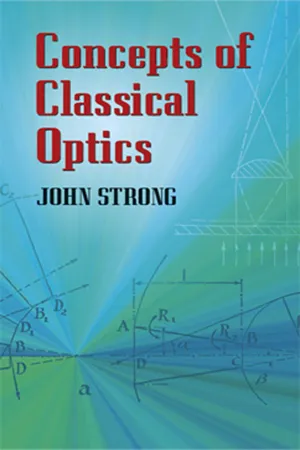
- 720 pages
- English
- ePUB (mobile friendly)
- Available on iOS & Android
Concepts of Classical Optics
About This Book
An intermediate course in optics, this volume explores both experimental and theoretical concepts, offering practical knowledge of geometrical optics that will enhance students' comprehension of any relevant applied science. Its exposition of the concepts of classical optics is presented with a minimum of mathematical detail but presumes some knowledge of calculus, vectors, and complex numbers.
Subjects include light as wave motion; superposition of wave motions; electromagnetic waves; interaction of light and matter; velocities and scattering of light; polarized light and dielectric boundaries; double refraction; and the interference of two sources laterally separated. Additional topics cover Fresnel and Fraunhofer diffraction; coherent sources separated in depth; applications of physical optics; images of points by single surfaces and by systems of surfaces; magnification, aperture, and field; and image defects.
Illustrative problems appear throughout the text, assuring students of an opportunity to attain a full understanding of the material. The appendixes feature short topics of lively research interest that can be used simply for reference or formally incorporated by the instructor into the course.
Frequently asked questions
Information
Chapter I
Light as Wave Motion
Table of contents
- DOVER BOOKS ON PHYSICS
- Title Page
- Copyright Page
- Dedication
- Preface
- Table of Contents
- Introduction
- Chapter I - Light as Wave Motion
- Chapter II - Superposition of Wave Motions
- Chapter III - Electromagnetic Waves
- Chapter IV - Interaction of Light and Matter
- Chapter V - Velocities and Scattering of Light
- Chapter VI - Polarized Light and Dielectric Boundaries
- Chapter VII - Double Refraction—Calcite and Quartz
- Chapter VIII - Interference of Two Sources Laterally Separated
- Chapter IX - Fresnel Diffraction
- Chapter X - Fraunhofer Diffraction
- Chapter XI - Coherent Sources Separated in Depth
- Chapter XII - Applications of Physical Optics
- Chapter XIII - Images of Points by Single Surfaces
- Chapter XIV - Images of Points by Systems of Surfaces
- Chapter XV - Magnification, Aperture, and Field
- Chapter XVI - Image Defects
- Appendix A - Applications of Interferometry
- Appendix B - Interferometers
- Appendix C - The Kösters Double-image Prism
- Appendix D - Interferometry with Savart’s Plate
- Appendix E - Apodization
- Appendix F - Application of Fourier Transformations in Optics: Interferometric Spectroscopy
- Appendix G - Some Modern Concepts of Light
- Appendix H - The Speed of Light
- Appendix I - Radiation Detectors and Measuring Devices
- Appendix J - Microwave Experiments and Their Optical Analogues
- Appendix K - The Wave Theory of Microscopic Image Formation
- Appendix L - Modern Trends in Methods of Lens Design
- Appendix M - Graphical Ray Tracing
- Appendix N - Fiber Optics
- Appendix O - Optical Filters
- Appendix P - Diffraction Gratings
- Appendix Q - Mathematical Review
- Problems
- Index
- A CATALOG OF SELECTED DOVER BOOKS IN SCIENCE AND MATHEMATICS